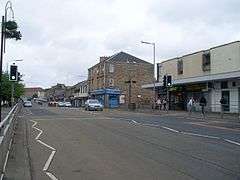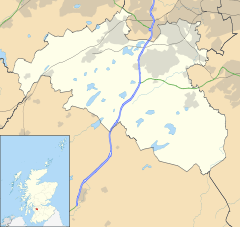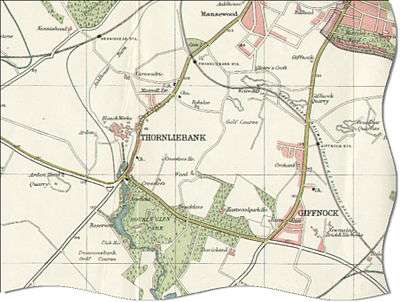Thornliebank
| Thornliebank | |
 Shops on Main Street |
|
 Thornliebank |
|
| Council area | East Renfrewshire |
|---|---|
| Lieutenancy area | Renfrewshire |
| Country | Scotland |
| Sovereign state | United Kingdom |
| Post town | GLASGOW |
| Postcode district | G46 |
| Dialling code | 0141 |
| Police | Scottish |
| Fire | Scottish |
| Ambulance | Scottish |
| EU Parliament | Scotland |
| UK Parliament | East Renfrewshire |
| Scottish Parliament | Eastwood |
Coordinates: 55°48′22″N 4°19′01″W / 55.806°N 4.317°WThornliebank (Scots: Thonliebank, Scottish Gaelic: Bruach nan Dealgan) is a suburb of Glasgow in East Renfrewshire, Scotland, 6 miles (10 km) south of Glasgow's city centre. It is served by Thornliebank railway station and lies to the east of the M77 motorway.
History

It is not known when Thornliebank was first settled although it has been ascertained that it did not exist prior to the 18th century. The village first makes its appearance on Thomas Richardson's map of 1795 and was, at the time, referred to as 'Thorny Bank', a title believed to have been inspired by the substantial number of thorn trees that were prevalent in the area. In 1789 it was a little street of cottages but it had grown by 1845, to have a population of 1366. This was largely due to the Crum family, who established and ran the Thornliebank printworks. John Crum founded the works in Main Street in 1778 to print locally woven linen.[1]
Walter Crum who was in charge by 1819 was a chemist and Fellow of the Royal Society. He replaced spinning and weaving by calico printing with bleaching, turkey red dyeing and "beetling". This brought immigrants from Northern Ireland and the New Statistical Account of Scotland described Thornliebank as "a very flourishing village where, thirty years ago, three families did not exist".[1]
Walter's son Alexander Crum who took over the printing works was a major philanthropist supporting housing, education, and leisure facilities in the village. He also provided funds for the village club and Thornliebank Parish Church.[1] Alexander Crum was Member of Parliament for Renfrewshire from 1880 to 1885. After his death he was commemorated by the Crum Library which was designed by the Scottish architect Sir Rowand Anderson and formally opened on 20 March 1897.[2]
Transport
Thornliebank has good transport links. Thornliebank Station is the main transport hub, trains run from here to East Kilbride or Glasgow Central.
Trains to Glasgow Central are typically at 6 and 36 minutes past the hour, whilst East Kilbride trains tend to be 20 past and 10 to the hour.
First Glasgow 10, 57 and 57A pass by the station:
57 runs in an anti-clockwise circle: Auchinairn, Springburn, City Centre, Shawlands, Thornliebank Arden and Darnley Housing Schemes, then onto Silverburn, Ibrox, Glasgow City Centre, Springburn & Auchinairn.
(10 operates clockwise in the reverse route of the 57.)
57A runs from Auchinairn via Springburn, City Centre, Shawlands and Thornliebank to Kennishead Flats.
Other buses to Thornliebank:
The Glasgow Citybus 49 operates from Silverburn to Shawlands via Thornliebank on Sundays only.
The Glasgow Citybus 374 links Silverburn, to Thornliebank and Shawlands in much the same way.
First 38, 38A, 38B & 38C serve the nearby Woodfarm High School and residential area.
Schools
Thornliebank Primary School is the only primary school in Thornliebank.Woodfarm High School is a secondary school situated in Woodfarm, Thornliebank and has around 800 pupils. St. Vincents' primary school in adjoining Carnwadric provides Roman Catholic education for the wider area and St. Ninians' High School in nearby Eastwood also provides for higher education and has, on more than one occasion been the best high school in Scotland.
Church
Thornliebank Parish Church - web site: http://www.thornliebankparishchurch.org/
St. Vincent de Paul - RC Church.
Facilities
Main Street: Church of Scotland, Saint Vincent de Paul Catholic church, Library, Thorntree Hall, Thornliebank Health Centre and Thornliebank Bowling Club.
Sport
Thornliebank F.C. were a senior football club in existence between 1875 and 1907. They reached the 1880 Scottish Cup Final.
References
- 1 2 3 Portal to the Past: East Renfrewshire's Heritage Collection - Thornliebank
- ↑ Glasgow Herald 22 March 1897
